Home Decor
How Batik Symbolism Can Create Harmony and Balance in Your Home
See how Batik symbolism can enhance your home’s harmony and balance, and discover which patterns might resonate with your personal space.

Batik symbolism can transform your home by infusing it with deep meaning and a sense of balance. You can use patterns like the Kawung, which promotes serenity, or the Ceplok, fostering unity and emotional warmth. Incorporating Batik textiles in your decor—like cushions, wall art, or tablecloths—creates a harmonious atmosphere that enhances visual appeal. These vibrant designs not only beautify your space but also serve as cultural reminders that inspire conversation. By strategically placing Batik pieces, you actively cultivate a nurturing environment. Want to explore how to harmonize your home even further? You might find more valuable insights waiting for you.
Key Takeaways
- Batik motifs like Kawung and Ceplok symbolize balance and unity, fostering a serene and harmonious atmosphere in your home.
- Incorporating Batik textiles in decor, such as curtains and pillow covers, enhances warmth and visual balance, enriching your living spaces.
- Unique Batik patterns tell cultural stories, promoting discussions and adding depth to your home environment while reflecting values of harmony and balance.
- Strategic placement of vibrant Batik pieces can transform the ambiance, inviting positive energy and a sense of nurturing throughout the home.
- Batik art enhances aesthetics, merging traditional craftsmanship with modern design, resulting in a cohesive and inviting living environment.
The Essence of Batik Symbolism

Batik symbolism is more than just beautiful patterns; it's a way to infuse your home with meaning and harmony. By incorporating Batik motifs like the Kawung, you invite balance into your living space. This particular design symbolizes equilibrium, promoting a serene atmosphere that enhances your home decor.
Similarly, the Ceplok pattern represents unity and interconnectedness, reflecting the bonds of family and community. Using this motif can elevate the emotional ambiance of your interior design, creating a sense of togetherness. Additionally, the vibrant colors and intricate patterns found in Indonesian decorative pillows can complement Batik textiles wonderfully, further enriching your home.
Batik's Cakar Ayam design signifies diligence and prosperity, introducing positive energy flow that contributes to a harmonious home environment. When you choose Batik textiles, such as curtains or cushion covers, you're not just adding aesthetic appeal; you're also tapping into rich cultural traditions that foster tranquility.
Furthermore, incorporating Batik art pieces serves as a conversation starter and a reminder of the values of harmony and balance inherent in this tradition. By thoughtfully integrating these symbols into your home, you can create a space that resonates with peace and cultural depth, making your living area not just beautiful, but meaningful. Explore batik home decor ideas such as using batik fabrics as throw pillows or table runners, or displaying batik artwork as wall hangings or framed pieces. These small touches can bring a sense of cultural connection and appreciation for traditional craftsmanship into your home. Incorporating batik home decor ideas can also be a way to support and honor the artisans who create these beautiful works of art.
Historical Background of Batik
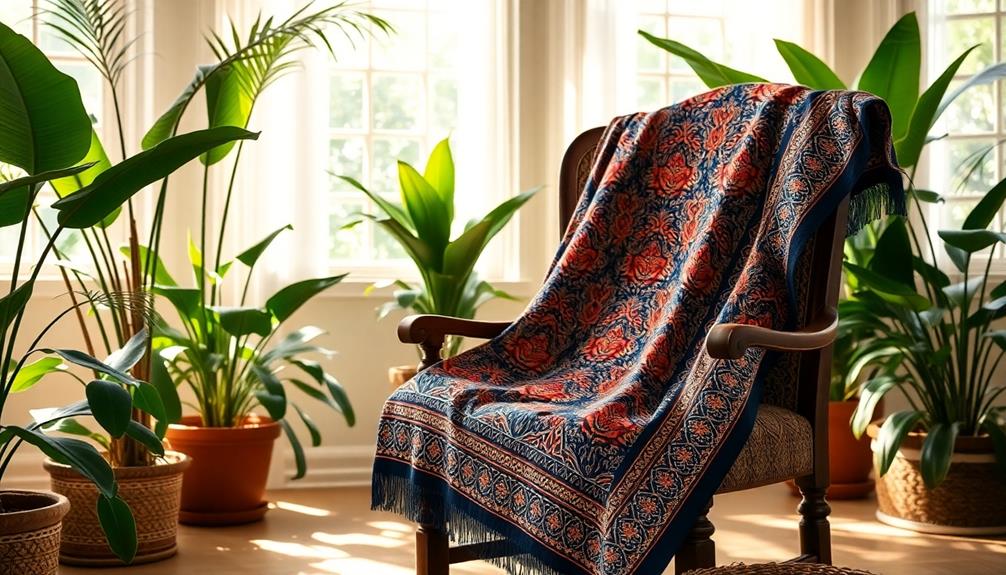
The rich cultural significance of Batik is deeply rooted in its historical background, which traces back to the Indonesian island of Java. This ancient textile art form originated as early as the 4th or 5th century AD, showcasing the skillful use of the wax-resist dyeing process.
The term "batik" derives from a Javanese word meaning "to dot" or "to stipple," reflecting the intricate patterns that characterize this craft. Batik, much like the intricate designs of Indonesian decor masks, holds a special place in Indonesia's cultural heritage, and its motifs often convey deeper meanings tied to traditions and beliefs.
In 2009, UNESCO recognized Batik as a Masterpiece of Oral and Intangible Heritage, highlighting its global importance.
Here are some key aspects of Batik's historical significance:
- Cultural Traditions: Specific designs are reserved for holidays and ceremonies.
- Symbol of Nobility: Certain patterns signify social status and nobility.
- Generational Legacy: The art has evolved through family traditions, showcasing vibrant cultural heritage.
Key Batik Patterns and Their Meanings

When decorating your home, incorporating key Batik patterns can greatly enhance the ambiance and meaning of your space. Each pattern carries unique symbolism that can foster harmony and balance in your environment.
The Kawung pattern, with its interlocking circles or squares, symbolizes balance and harmony, making it ideal for evoking tranquility. Additionally, integrating traditional art elements, such as Indonesian decor masks, can further enrich the cultural storytelling in your home, adding depth to your decor traditional artistry in masks.
The Ceplok pattern features bold central motifs that embody unity and adaptability, perfect for creating a cohesive aesthetic in your living areas.
Meanwhile, the Nitik pattern, with its tiny dots arranged in geometric designs, represents fertility and growth, encouraging positive energy and an uplifting atmosphere.
If you're looking for strength, consider the Parang pattern, characterized by diagonal lines that symbolize power and resilience, instilling stability within your home.
Incorporating Batik in Home Decor
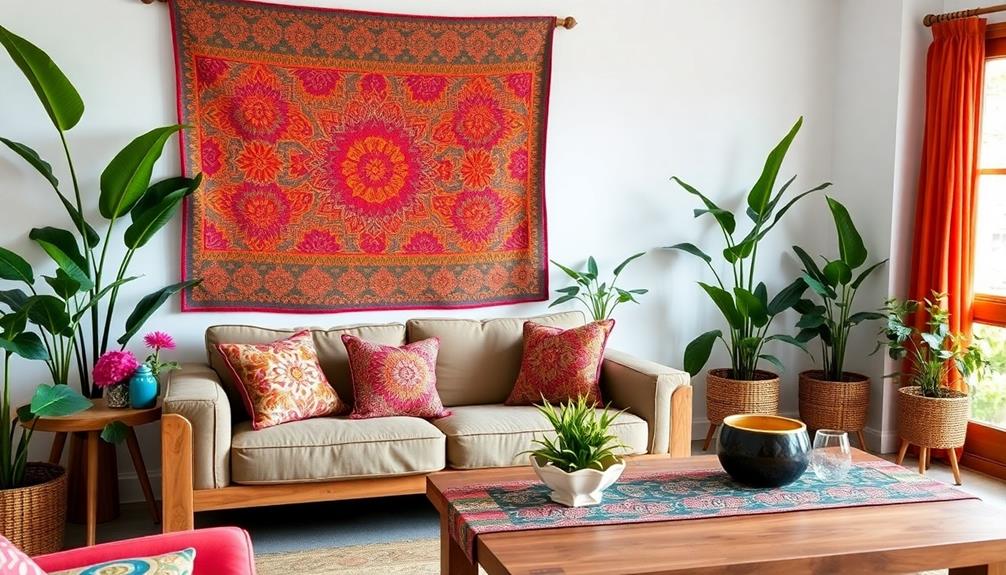
Integrating Batik into your home decor not only enhances visual appeal but also brings rich cultural significance to your space. You can easily incorporate batik motifs and vibrant colors into various elements of your home, creating an inviting atmosphere that reflects traditional artistry.
Additionally, the intricate designs of Indonesian decor masks can complement batik pieces, further enriching your home's aesthetic.
- Batik fabric for curtains and pillow covers: These pieces add warmth and intricate patterns, elevating your living space.
- Batik tablecloths or runners: They create a unique dining experience, infusing meals with cultural richness while promoting harmony and prosperity among family members.
- Batik-inspired wall art: Framed pieces or canvas prints act as eye-catching focal points, celebrating heritage and enhancing the overall decor.
Creating Balance With Batik Textiles

Batik textiles offer a unique way to bring harmony and balance into your home. By incorporating these stunning fabrics, you can create an inviting ambiance that resonates with unity and stability. Geometric patterns like the Kawung design symbolize balance, while motifs such as the Ceplok pattern enhance feelings of calm in shared spaces.
Here's a quick overview of how different batik designs can impact your decor:
| Design | Symbolism | Effect on Space |
|---|---|---|
| Kawung | Harmony | Serene atmosphere |
| Ceplok | Stability | Enhanced unity and calm |
| Mega Mendung | Life-giving rains | Revitalizing and nurturing ambiance |
| Vibrant Colors | Cultural artistry | Infuses positive energy |
| Geometric Patterns | Visual balance | Cohesive decor aesthetic |
Utilizing vibrant batik colors and designs in items like curtains or pillow covers can infuse your environment with cultural artistry. Strategically placing these batik pieces throughout your home cultivates a visually balanced aesthetic, allowing you to enjoy the intricate stories and meanings behind each design. Embrace the beauty of batik textiles to enhance your space's harmony and stability.
Batik as Cultural Storytelling

Incorporating batik textiles into your home isn't just about aesthetics; it's a way to weave cultural narratives into your living space.
Batik patterns serve as a medium for storytelling, reflecting deep cultural heritage and societal values. Each design conveys themes of harmony and balance, enriching your environment with symbolic meanings.
Additionally, using natural materials in conjunction with batik can enhance the overall ambiance, creating a space that resonates with traditional Indonesian style.
Consider these impactful batik motifs:
- Kawung pattern: Featuring interlocking circles, it symbolizes the eternal cycle of life and hope for enduring balance.
- Nitik pattern: Representing fertility and growth, it inspires a nurturing atmosphere, enhancing family harmony.
- Ceplok pattern: With its geometrical shapes, it embodies the essence of unity, resonating with togetherness in your home decor.
Harmonizing Spaces With Color
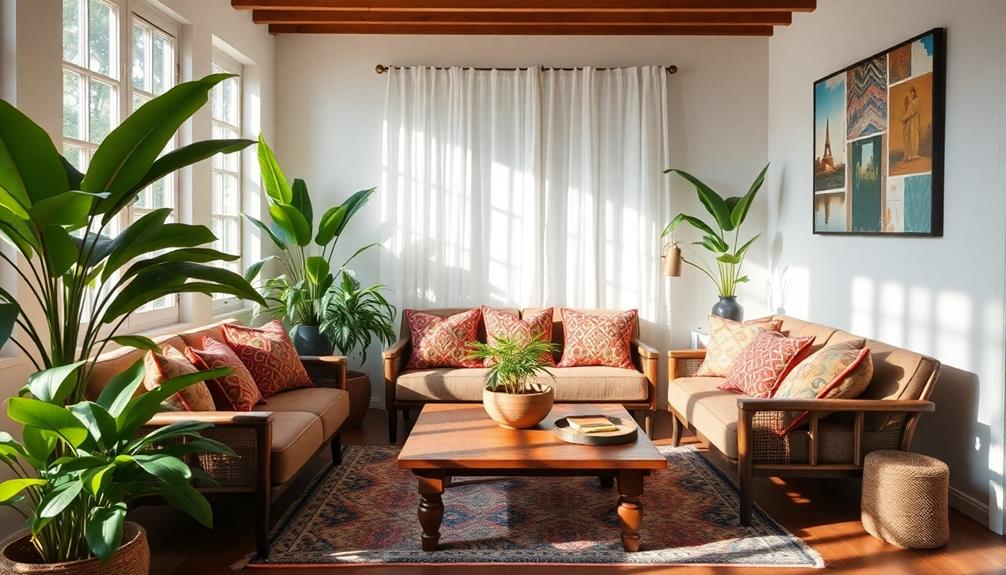
Harmonizing your living space with color can transform the atmosphere and evoke a sense of warmth and positivity. By incorporating batik fabric into your home decor, you enhance the color palette while embracing intricate patterns that invite balance and harmony. The Kawung pattern, with its interlocking circles, symbolizes unity, making it perfect for cushions or wall hangings.
To visualize how colors and patterns can work together, consider this layout:
| Batik Motif | Color Palette | Decorative Element |
|---|---|---|
| Kawung | Earthy tones | Cushion covers |
| Mega Mendung | Blues and greens | Tablecloth |
| Floral patterns | Warm vibrant hues | Curtains |
Using batik-inspired curtains or tablecloths creates focal points that not only showcase unique designs but also stir conversations. The Mega Mendung pattern represents life-giving rains, instilling tranquility and a connection to nature. By integrating batik motifs into your decor, you embrace a rich cultural heritage that resonates with values of unity and balance, fostering a harmonious atmosphere throughout your home.
Modern Applications of Batik
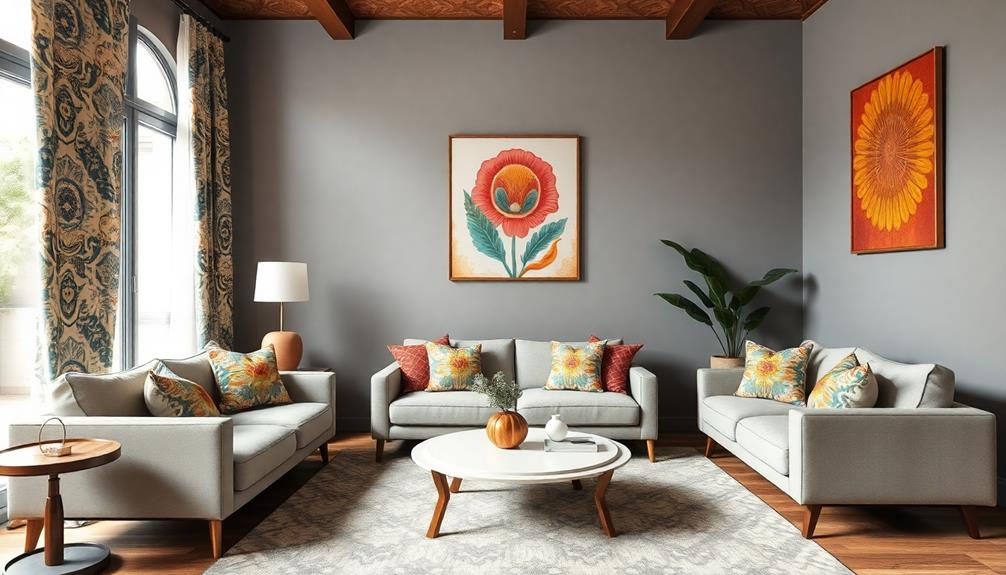
Home decor can effortlessly blend tradition with modernity when you embrace batik's vibrant patterns and colors. By incorporating batik fabric into your living space, you invite a touch of cultural artistry that enhances the overall aesthetic.
These traditional patterns can transform ordinary items into stunning focal points, creating a warm and harmonious atmosphere. Additionally, the use of natural materials and sustainable practices in designs, similar to luxury tropical design aesthetics, aligns beautifully with the ethos of batik artistry.
Consider these modern applications of batik:
- Batik quilts: Serve as both functional items and artistic statement pieces, showcasing unique designs and textures.
- Upholstery: Contemporary designers are using batik for furniture upholstery, merging traditional craftsmanship with modern design elements for a stylish finish.
- Wall art: Batik can also be used creatively in wall art, providing an eye-catching blend of color and cultural heritage.
The versatility of batik allows you to explore various creative projects, from curtains and pillow covers to tablecloths. Each piece not only adds beauty but also honors the rich traditions behind this exquisite fabric.
Frequently Asked Questions
What Does Batik Symbolize?
Batik symbolizes cultural heritage and identity. Each pattern conveys unique meanings, like strength, harmony, and divine blessings. By understanding these symbols, you can appreciate their significance and enhance your living space's character and ambiance.
How Is Batik Used in Everyday Life?
How do you express your culture daily? You use batik in your clothing, home decor, and accessories, embracing its vibrant patterns and rich heritage, transforming ordinary spaces into reflections of your identity and creativity.
What Is the Importance of Batik?
Batik's importance lies in its rich cultural significance and storytelling. You appreciate its intricate designs that reflect heritage and philosophy, connecting you to a broader community while enhancing your living space with beauty and meaning.
What Makes Batik Special?
Batik's special because it blends intricate artistry with deep cultural meanings. Each design you see tells a story, reflecting values like balance and strength. You'll appreciate its vibrant colors and rich heritage adorning your space.
Conclusion
By embracing batik symbolism in your home, you're not just decorating; you're infusing your space with rich cultural narratives and meaningful patterns. You might think it's too bold for your decor style, but batik's versatility allows it to blend beautifully with various aesthetics. Whether you choose vibrant colors or subtle hues, batik can create harmony and balance, turning your home into a sanctuary that reflects both your personality and a deep appreciation for artistic heritage.
Home Decor
Feng Shui Secrets Designers Swear By to Create a Calm and Harmonious Home
I uncover essential Feng Shui secrets that designers rely on to cultivate a peaceful home, but there’s so much more to discover for ultimate serenity.
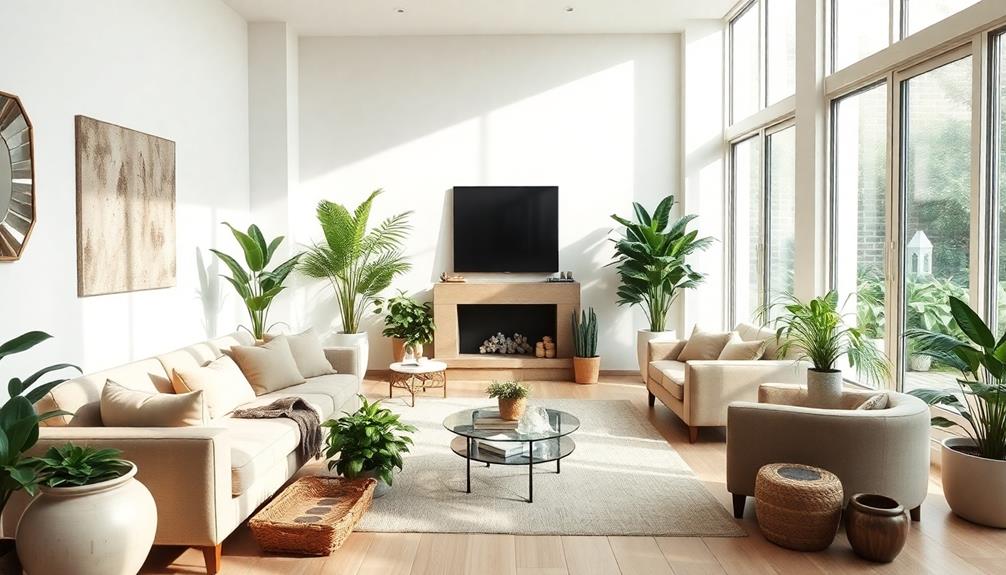
To create a calm and harmonious home, embrace Feng Shui principles that designers swear by. Start by using a Bagua map to identify energy flow in each area. Incorporate the five elements—Wood, Fire, Earth, Metal, Water—into your decor for balance. Prioritize soothing colors like green for family harmony and red for love. Avoid clutter to keep energy flowing freely and position furniture to enhance security and conversation. Use mirrors to amplify light and include natural elements, such as rounded-leaf plants. These strategies lay the foundation for a serene atmosphere, and you'll discover even more effective tips ahead.
Key Takeaways
- Utilize a Bagua map to identify specific areas of your home that correspond to different life aspects for targeted energy enhancement.
- Embrace soothing color palettes, like greens for family harmony and pinks for love, to create a calming environment.
- Position furniture in a command position, allowing for a clear view of the entrance, to promote security and positive energy flow.
- Maintain cleanliness and organization, especially in high-traffic areas, to prevent stagnation and enhance the flow of Chi.
- Introduce natural elements, such as rounded-leaf plants and mirrors, to amplify light and energy while fostering a nurturing atmosphere.
Understanding Feng Shui Principles
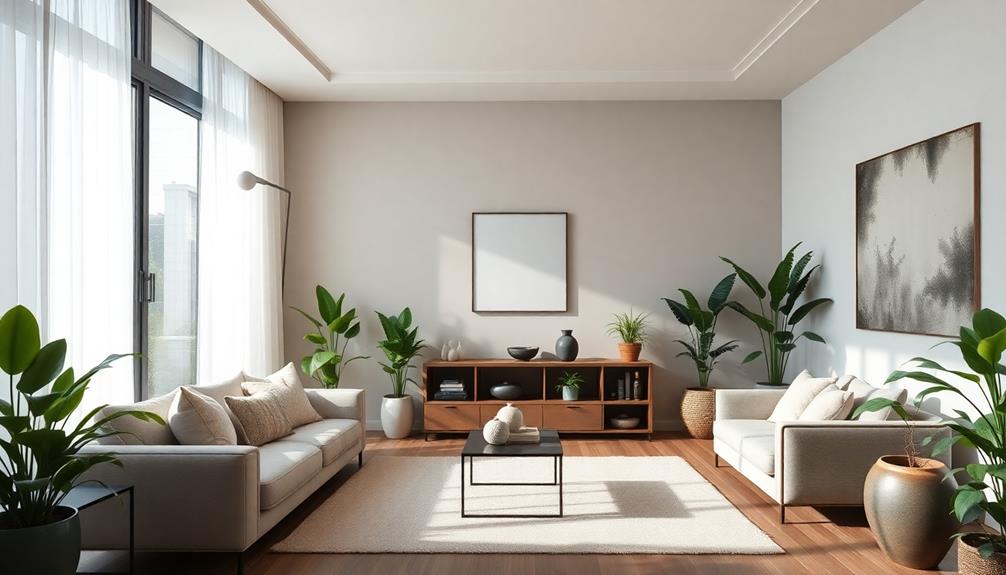
Understanding Feng Shui principles can transform your living space into a sanctuary of peace and balance. This ancient Chinese practice emphasizes the flow of energy, or Chi, in your environment. By making minor adjustments, you can create significant improvements in your quality of life.
Incorporating elements of Balinese design characteristics can enhance the natural flow of energy and create a harmonious atmosphere. The five elements of Feng Shui—Wood, Fire, Earth, Metal, and Water—are vital for achieving balance and harmony in your home. Each element links to specific colors and shapes that enhance positive energy.
Utilizing the Bagua map can guide your design decisions, as it divides your space into nine areas that correspond to different aspects of life, such as career and relationships.
Incorporating Yin and Yang concepts guarantees that opposing forces are harmonized, promoting well-being and tranquility. Proper furniture placement is essential; positioning key items in a commanding position and avoiding sharp corners facilitates a smooth energy flow.
Essential Feng Shui Tools
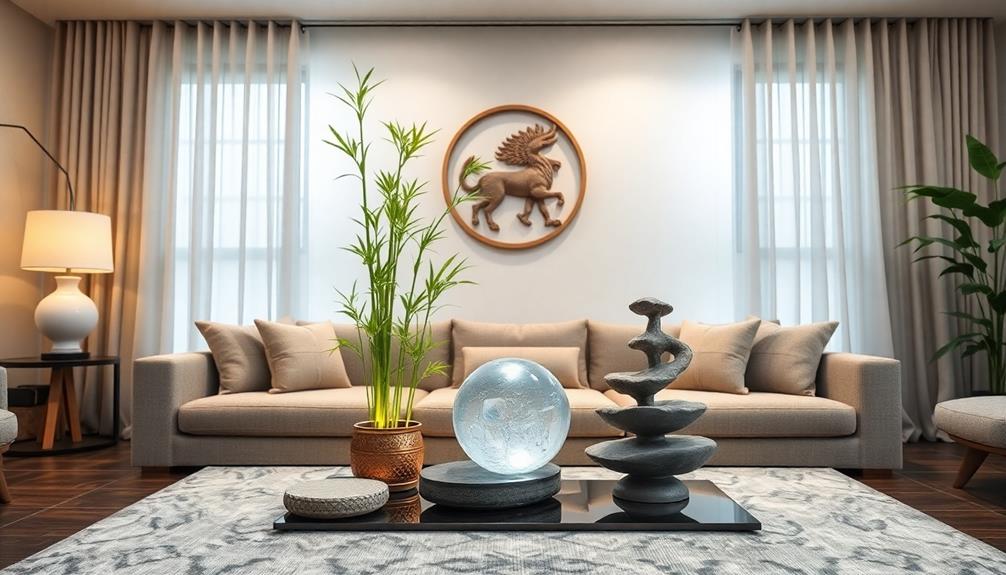
To create a harmonious environment, you'll want to utilize specific Feng Shui tools that enhance the flow of positive energy in your home. One of the most essential tools is the Bagua Map, which divides your space into nine areas, each reflecting different life aspects. Use this map to identify where to focus your energy improvements.
Incorporating Feng Shui Symbols like Buddha statues or wind chimes can greatly enhance positive energy flow and shield against negativity. Additionally, the Five Elements—Wood, Fire, Earth, Metal, and Water—should be included in your decor to balance the elements and support various life aspects.
Additionally, consider the color palette in your interior design ideas. Specific colors promote different energies, such as pink and red for love or green for finances.
Here's a quick reference table for your Feng Shui toolkit:
| Tool | Purpose |
|---|---|
| Bagua Map | Identify focus areas for energy flow |
| Feng Shui Symbols | Enhance positive energy and protection |
| Five Elements | Balance energies in decor |
| Color Palette | Promote desired outcomes |
Key Dos and Don'ts
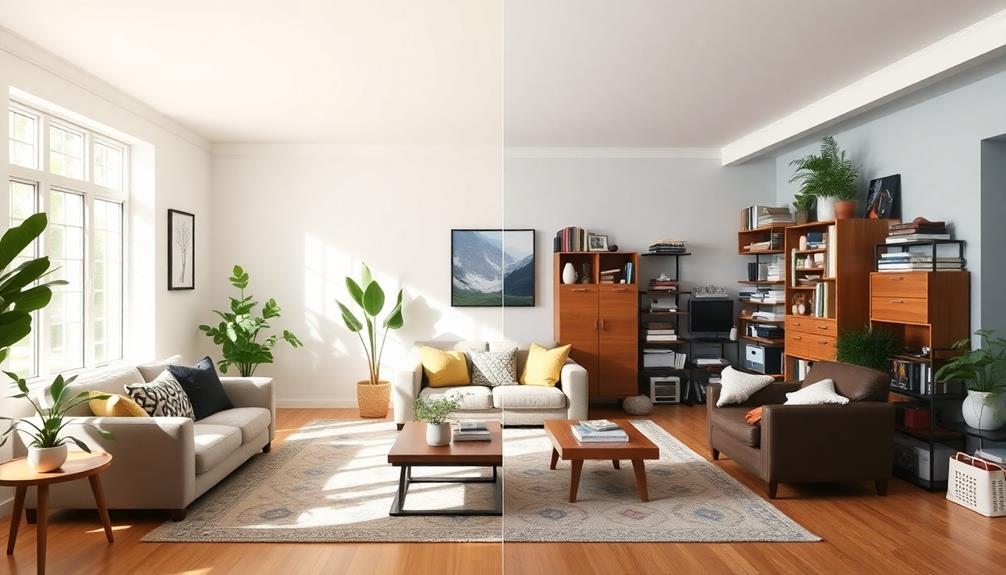
When it comes to creating a calm home with Feng Shui, following key Dos and Don'ts can make all the difference.
First, embrace Feng Shui tips by using soothing colors in your space. Opt for green to enhance family harmony and red to invite love, boosting positive energy throughout your home. Incorporating elements like Indonesian decorative pillows can add vibrant colors and intricate patterns that enhance the ambiance.
On the other hand, don't let clutter accumulate; it obstructs energy flow (Chi) and can lead to feelings of stagnation and stress.
Next, pay attention to furniture placement. Make sure your furniture is in a command position, ideally placed diagonally from the entrance. This setup fosters a sense of security and control.
Conversely, avoid sharp-edged furniture or decor, as they can create negative energy (Sha Qi) and discomfort in your environment.
Room-Specific Guidelines
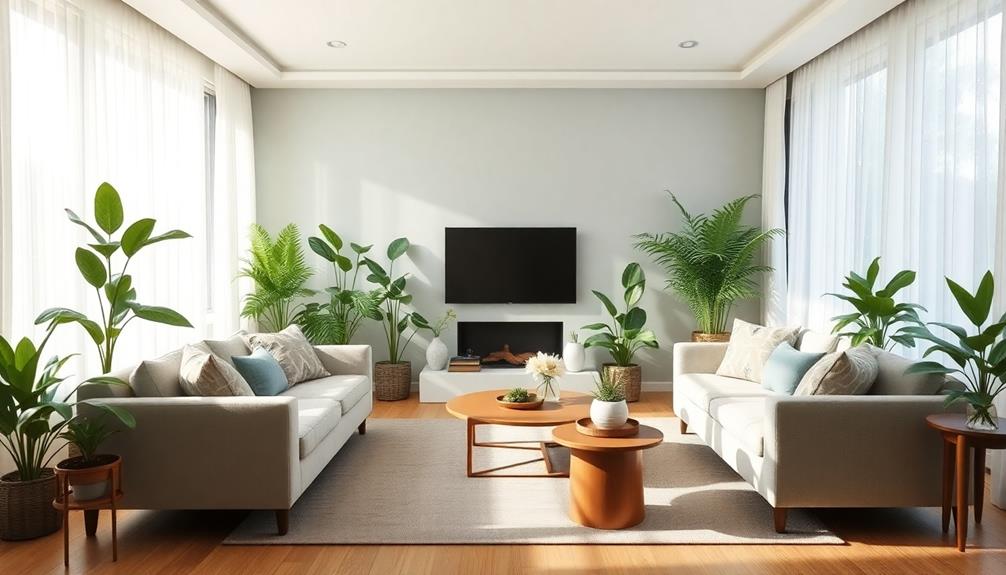
Creating a calm environment goes beyond general principles; it requires attention to each room's unique energy. For example, incorporating elements from luxury tropical designs can enhance the tranquility of your living space.
In your living room, position furniture to promote positive energy flow and encourage conversation. Soft lighting and comfortable seating create a peaceful and calming atmosphere, enhancing social interaction.
For the kitchen, keep the stove and sink clean and clutter-free. Ascertain your fridge is well-stocked and place the stove in a commanding position to optimize energy in your home.
In the bedroom, arrange your bed to have a clear view of the door, using calming colors like soft blues or greens. This creates balance and promotes restful sleep by minimizing distractions from electronics.
Maintain cleanliness in your bathroom, using soft lighting for a serene feel. Keep the toilet lid down and doors closed to preserve privacy and positive energy.
For your home office, position your desk to face the entrance, giving you a sense of control. Ascertain your workspace is organized and filled with natural light to enhance productivity and focus.
Incorporating small touches of color red can also invigorate your space, promoting smooth and uninterrupted energy flow.
Enhancing Energy Flow

Enhancing energy flow in your home is vital for fostering a calm and inviting atmosphere. To achieve this, it's important to create clear pathways, allowing Chi to circulate freely.
Regular decluttering is important; removing unnecessary items prevents stagnation and promotes positive energy to flow throughout your space. Incorporating elements of modern tropical aesthetics in Bali can further enhance this flow, as they emphasize natural materials and open layouts that invite light and air.
Consider the flow of your furniture. Positioning it diagonally from the entrance creates a commanding view, giving you a sense of control and security. This simple adjustment can greatly enhance the overall energy dynamics of your room.
Incorporating mirrors is another effective way to amplify light and energy, especially in darker areas. They not only brighten spaces but also create a visual expansion, making the environment feel more open and harmonious.
Lastly, introduce natural elements like plants with rounded leaves to invigorate your space, promoting a nurturing vibe.
These small changes contribute to creating balance and harmony in your home. By focusing on these strategies, you'll cultivate an environment where energy that flows effortlessly supports your well-being and tranquility.
Frequently Asked Questions
How to Bring Peace at Home Feng Shui?
To bring peace at home, clear clutter to enhance energy flow, position furniture for security, use soothing colors, incorporate warm lighting, and add natural elements like plants to foster a calming atmosphere.
What Is Bad Feng Shui for a House?
Beware of bad feng shui! If your entrance faces a staircase, sharp corners threaten comfort, clutter clogs chi, dark areas dampen mood, and broken items breed stagnation. Tidy up to transform your space!
What Are the Feng Shui Rules for a House?
To create positive energy in your house, follow basic Feng Shui rules. Position your entrance welcomingly, declutter spaces, arrange furniture for comfort and visibility, and incorporate natural elements like plants to enhance harmony and flow.
How to Make a House Lucky Feng Shui?
To make your house lucky, position your entrance for clear views, incorporate the five elements in your decor, keep spaces clutter-free, use mirrors for light, and enhance areas linked to wealth and health.
Conclusion
Just like a well-tended garden thrives, your home flourishes when you embrace Feng Shui principles. By nurturing the energy flow and respecting the essential tools, you transform your space into a tranquil oasis. Remember, a calm home reflects a calm mind, much like a still pond mirrors the sky. So, as you rearrange and refine your surroundings, envision your home as a sanctuary where peace blossoms, inviting harmony into every corner of your life.
Home Decor
The Feng Shui Furniture Rule That Will Instantly Improve Your Space
Get ready to transform your space with the Feng Shui furniture rule that promotes harmony and flow—discover how to elevate your environment today!
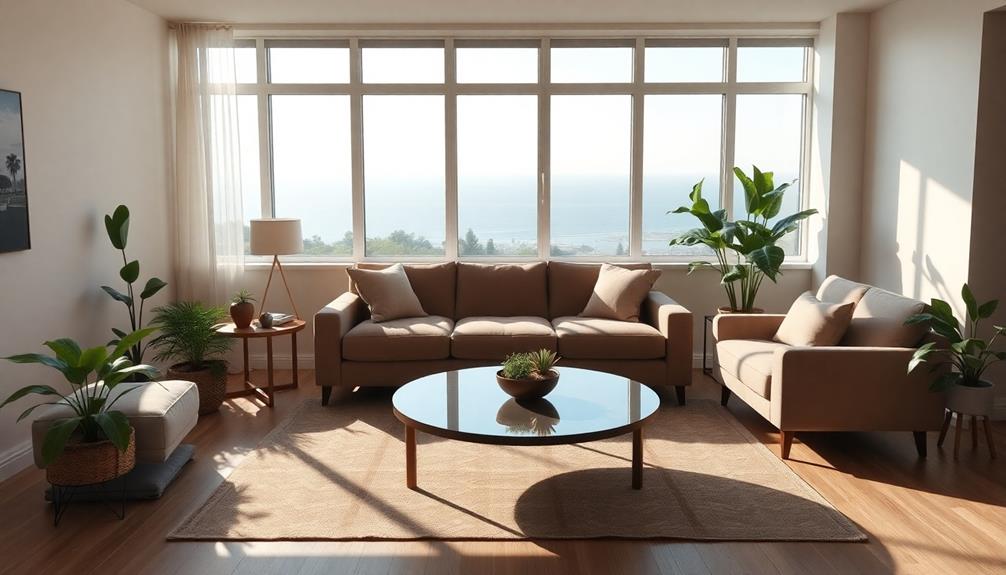
To instantly improve your space, position your furniture in the command position. This means placing key pieces like your bed or desk in a way that you can see the entrance while feeling supported by a solid wall behind you. Avoid pushing furniture against windows or corners to keep energy flowing. Make sure pathways are clear for easy movement. Adding natural elements, like plants, enhances this flow further. With a few tweaks, you can create a harmonious and inviting atmosphere. If you want to explore more ways to elevate your space, there's much more to discover!
Key Takeaways
- Position beds and desks in the command position to enhance energy flow and visibility of entrances for greater comfort and relaxation.
- Clear pathways and avoid clutter to facilitate movement, preventing energy stagnation and promoting tranquility within your space.
- Incorporate natural elements like plants to ground energy and refresh the atmosphere, enhancing vitality in your environment.
- Use soothing colors that resonate with you to influence mood and create a calming ambiance throughout your living space.
- Regularly reassess and update your furniture arrangement to align with personal growth, seasonal changes, and evolving preferences.
Understanding the Command Position

When you understand the command position, you can considerably enhance the flow of energy in your home. The command position refers to the strategic placement of furniture, particularly your bed and desk, allowing you to see the entrance while maintaining distance from direct sightlines. Incorporating elements like Indonesian decorative pillows can further enhance your space with their vibrant colors and intricate patterns, promoting a warm and inviting atmosphere. This setup fosters a sense of security and control, promoting relaxation.
In the bedroom, position your bed against a solid wall, ensuring you have visibility of the door while keeping pathways clear for ideal energy flow. This arrangement not only creates a peaceful sanctuary but also enhances your overall well-being.
In your living room, placing seating in a command position encourages conversation and interaction, enhancing the overall social atmosphere. Similarly, in your home office, position your desk to face the entrance, empowering you to feel aware of your surroundings while you work.
Avoid placing furniture against windows or crammed into corners, as this can disrupt energy flow and create feelings of vulnerability.
Balancing Energy Flow

Mastering the command position sets the foundation for a harmonious living space, but balancing energy flow takes it a step further. To truly enhance your environment, focus on furniture arrangements that create clear pathways and avoid clutter. This allows energy to circulate freely and prevents stagnation.
Consider the following elements to improve your space:
| Element | Importance |
|---|---|
| Clear Pathways | Promote movement and prevent obstruction. |
| Natural Elements | Incorporate plants for grounding energy. |
| Soothing Colors | Use soft tones to enhance tranquility. |
| Visibility of Front Door | Foster comfort and reduce anxiety. |
Position larger furniture pieces to encourage interaction while ensuring visibility of entrances. This not only nurtures a sense of security but also supports social connections. Regularly reassess your furniture arrangement and embrace seasonal decor changes to maintain ideal energy flow. By doing so, you'll create a clutter-free environment that radiates balance and tranquility, transforming your space into a calming sanctuary. Prioritizing these aspects of Feng Shui will elevate your living experience and promote a serene atmosphere for you and your guests. Incorporating feng shui furniture ideas can also inspire creative layouts that maximize both functionality and harmony within your space. Consider using round tables to encourage equality in conversations or placing mirrors strategically to reflect natural light and amplify positive energy. These thoughtful adjustments will further align your home with Feng Shui principles, enhancing its overall warmth and inviting ambiance.
Optimal Furniture Placement
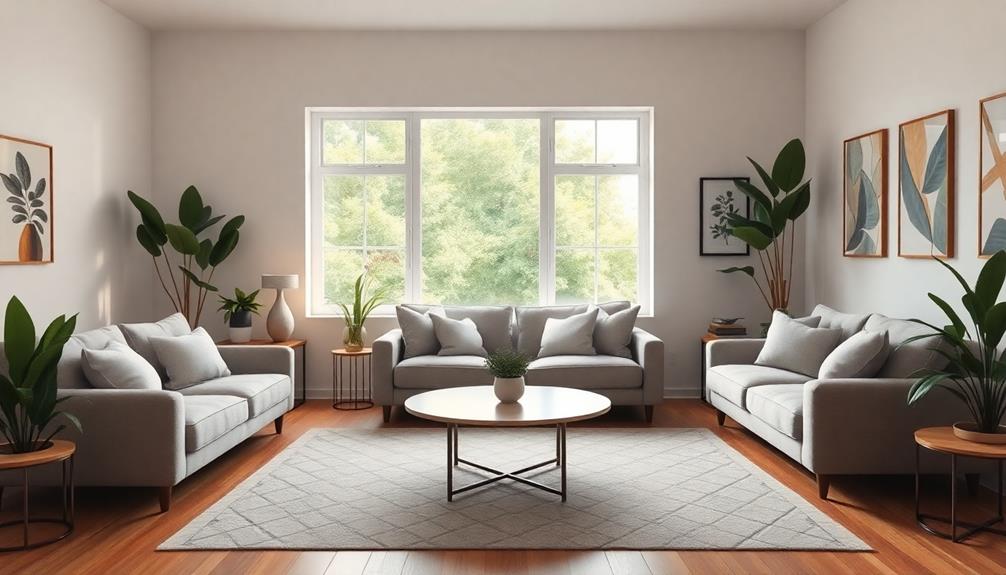
Optimal furniture placement is vital for creating a harmonious living space that promotes positive energy flow. To achieve ideal furniture placement, position larger pieces, like sofas, away from walls. This setup encourages an inviting atmosphere and facilitates conversation while ensuring you can see the front door for a sense of security.
Incorporating elements from Balinese design characteristics can further enhance the energy of your space by blending traditional craftsmanship with modern aesthetics. Avoid placing the back of the sofa against a window, as this blocks energy flow and may lead to feelings of instability.
Arrange seating to promote easy movement and interaction, keeping pathways clear to enhance overall energy. Incorporating natural elements, such as plants, can ground your space and elevate the energy. Place these near natural light sources for ideal growth, as they contribute to a vibrant environment.
Regular reassessments of your furniture arrangement are essential. By making seasonal adjustments, you can refresh your space, ensuring it continues to support your emotional well-being.
Always be open to tweaking your layout; sometimes, a simple shift can greatly enhance positive energy flow and create a more inviting atmosphere. Embrace these strategies to cultivate a space that nurtures both you and your guests.
Personalizing Your Space
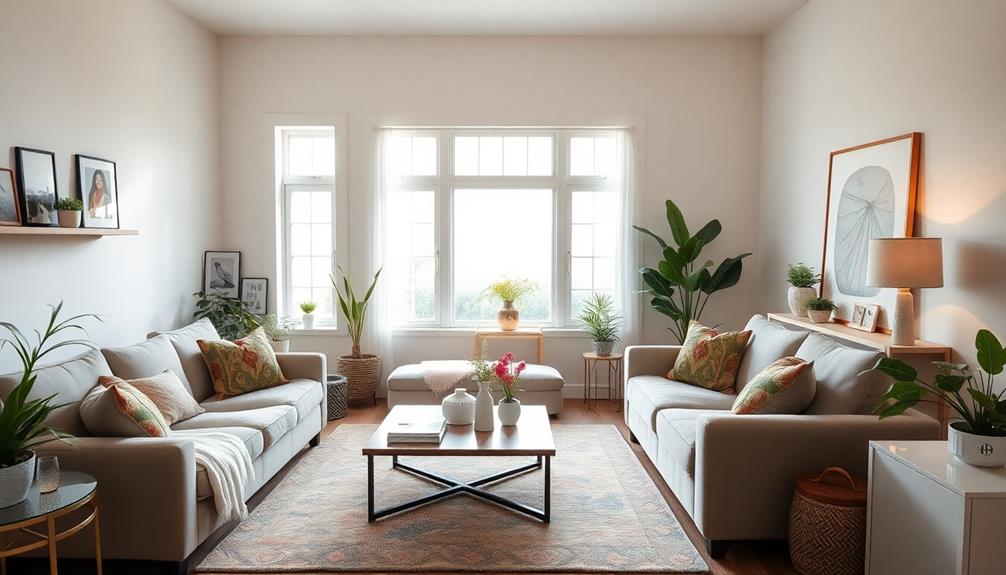
Personalizing your space transforms it into a reflection of who you are, making it feel more like home. Start by incorporating sentimental items like family photos or meaningful artwork, such as a unique Indonesian decor mask that represents rich cultural heritage. These pieces enhance your emotional connection to the space, fostering a sense of belonging.
Choose colors that resonate with you; they can greatly influence your mood and energy levels, promoting a calming atmosphere.
Don't forget to bring in natural elements such as plants and wood materials. These additions ground your space and provide a revitalizing connection to nature.
Regularly reassessing your decor allows you to reflect seasonal changes or personal growth, maintaining ideal energy flow and liveliness in your living area.
Thoughtful placement is key. Grouping objects in odd numbers can create visual appeal and elevate the overall harmony of the room.
Maintaining Harmony Over Time

Maintaining harmony in your space is essential for fostering a positive and inviting atmosphere. To guarantee your environment promotes ideal energy flow, regularly reassess your furniture arrangement. Seasonal changes often call for adjustments, so keep your space feeling fresh and welcoming.
| Action | Purpose |
|---|---|
| Declutter | Prevent stagnant energy |
| Incorporate | Utilize natural elements |
| Personal items | Evoke positive emotions |
| Schedule updates | Keep energy dynamic |
| Refresh energy | Create a calming atmosphere |
By decluttering consistently, you'll prevent stagnant energy, allowing tranquility to flourish. Incorporating natural elements like plants can further refresh energy, creating a calming atmosphere that nurtures your well-being. Don't forget to include personal items that evoke positive emotions, enhancing the overall harmony of your space.
Lastly, schedule periodic updates to your decor and furniture placement. This keeps your living space aligned with your evolving preferences and lifestyle. Embrace these practices to maintain harmony over time, guaranteeing your home remains a sanctuary that supports your journey to well-being.
Frequently Asked Questions
How to Feng Shui Your Space?
To feng shui your space, arrange furniture for clear pathways, promote conversation with seating, incorporate natural elements, use calming colors, declutter regularly, and strategically place mirrors to enhance light and energy flow.
How to Place Furniture According to Feng Shui?
Placing furniture's like arranging a dance; you want partners to face each other. Position your seating to encourage conversation, clear pathways for movement, and always guarantee a view of the door for security and comfort.
How Can I Improve My Room Feng Shui?
To improve your room's feng shui, position your bed for visibility of the door, declutter pathways, use soothing colors, add plants, and regularly reassess your arrangement for ideal energy flow and tranquility.
How Do You Arrange Furniture for Positive Energy?
To arrange furniture for positive energy, create clear pathways, position seating to face the door, encourage conversation with your layout, and incorporate natural elements. Regularly refresh arrangements to maintain an uplifting atmosphere in your space.
Conclusion
By following these feng shui principles, you can transform your space into a sanctuary that feels both inviting and balanced. Remember, it's all about creating harmony and flow. Have you considered how your furniture placement affects your daily energy? With a little mindfulness and personalization, you'll not only enhance your surroundings but also elevate your mood. Keep reassessing and adjusting as needed to maintain that perfect balance and guarantee your space continues to inspire you.
Home Decor
Why These 5 Feng Shui Principles Will Make Your Home Feel Complete
Transform your living space with these five Feng Shui principles that promise harmony and balance—discover how they can make your home feel truly complete.
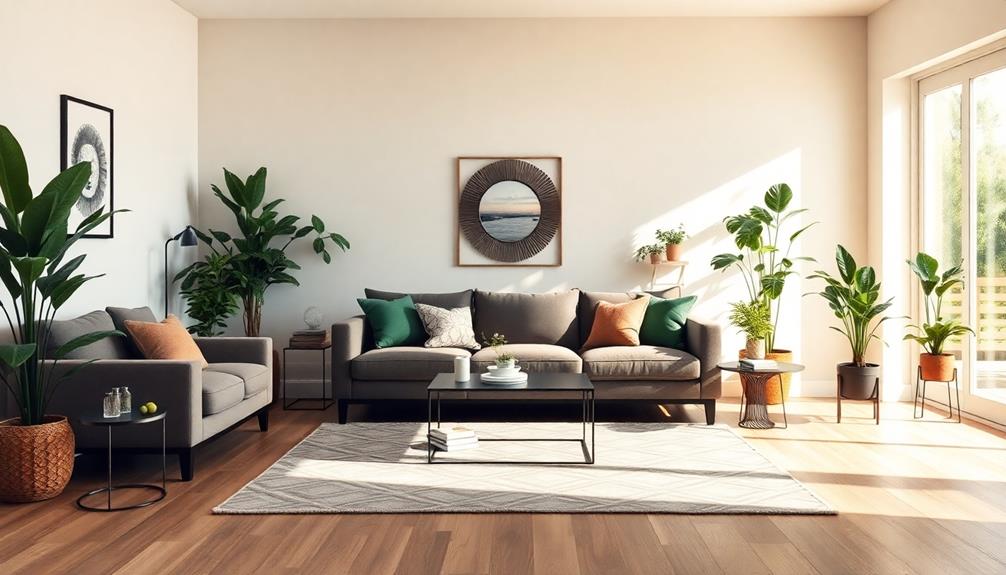
Incorporating these five Feng Shui principles can transform your home into a place of tranquility and balance. Start by decluttering to enhance energy flow and reduce stress, making your space feel inviting. Next, arrange your furniture strategically to promote good Chi and create functional zones. Thoughtful mirror placements can amplify light and positivity, while balancing the five elements in your decor fosters harmony and boosts relaxation. With these principles, you'll find your home feels complete and rejuvenating. Stick around to uncover even more ways to enhance your living space!
Key Takeaways
- Embracing Feng Shui principles enhances the flow of Chi, creating a lively and harmonious atmosphere in your home.
- Decluttering promotes positive energy circulation, reducing stress and chaos, leading to a more peaceful living space.
- Strategic furniture arrangement fosters an inviting environment, ensuring comfort and functionality in various areas of your home.
- Thoughtful use of mirrors boosts light and energy flow, reflecting positive elements and enhancing the overall ambiance.
- Balancing the five elements in design promotes relaxation and productivity, creating a sense of completeness and well-being in your home.
Understanding Feng Shui Principles
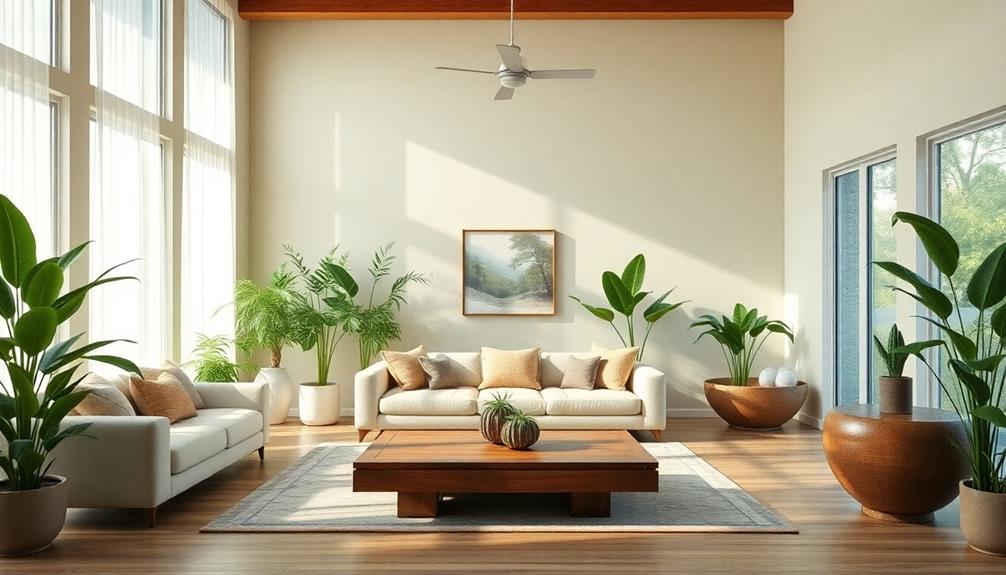
Feng Shui, an ancient Chinese practice, emphasizes the importance of energy flow, or Chi, in your living space. By understanding Feng Shui principles, you can create a balanced and harmonious environment that nurtures your well-being.
Central to this practice is the concept of Chi energy, which flows through your home, influencing your mood and liveliness. To enhance this flow of energy, consider incorporating elements of traditional Indonesian style home decor, which utilizes natural materials and emphasizes harmony with nature.
The Bagua Map serves as an essential tool, dividing your space into nine zones linked to different life aspects like wealth and health. Each zone can be activated by incorporating the five elements: Wood, Fire, Earth, Metal, and Water, ensuring a dynamic and organized space.
Feng Shui design also encourages the use of specific colors and materials to promote positive energy flow. For example, pink may attract love, while green can boost finances.
Additionally, integrating symbols like wind chimes or water features can further enhance the energy in your home.
Importance of Decluttering
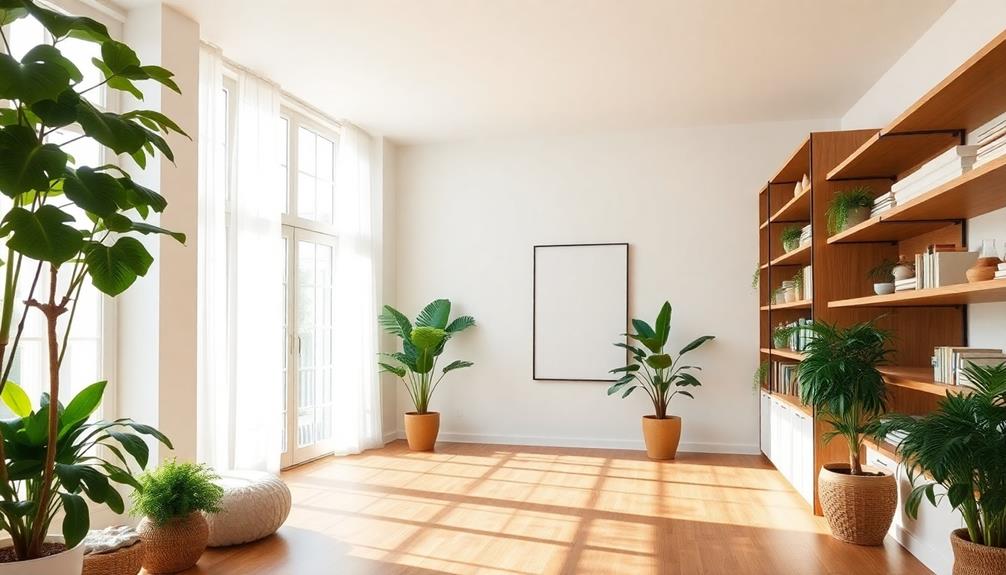
Decluttering is essential for maintaining a harmonious home, as it directly impacts the flow of chi, or energy, throughout your space. In Feng Shui, a clutter-free environment allows positive energy to circulate freely, enhancing your overall well-being. When you regularly declutter, you reduce chaos and stress, fostering mental clarity and emotional stability.
Here's how decluttering can transform your living space:
| Benefits of Decluttering | Effects on Well-being | Tips for Decluttering |
|---|---|---|
| Promotes positive energy | Reduces anxiety | Start small, focus on one area |
| Enhances relaxation | Improves sleep quality | Donate unused items regularly |
| Encourages creativity | Boosts mental clarity | Organize spaces effectively |
| Opens space for opportunities | Fosters emotional balance | Visualize your ideal space |
Strategic Furniture Arrangement

Arranging your furniture strategically can greatly enhance the flow of chi in your home, creating a more inviting and harmonious atmosphere. By positioning key pieces, like sofas and desks, to allow for clear visibility of entryways, you reduce feelings of vulnerability and boost comfort.
One essential element is placing your bed in a command position; ideally, it should face the door without being directly aligned with it. This arrangement promotes security and relaxation, crucial for restful sleep. Incorporating natural materials and earth tones, much like in Balinese interior design concepts, can further enhance the calming effect of your space.
Avoid sharp corners pointed toward seating areas, as they can foster discomfort and anxiety, disrupting your harmonious living space. Instead, utilize furniture to create distinct functional zones within a room. This encourages energy flow and supports various activities, enhancing the overall utility and vibe of your space.
Regularly reassessing your furniture placement can help maintain a balanced environment, allowing you to make adjustments that reflect your changing needs and preferences.
Thoughtful Use of Mirrors

Mirrors can be powerful tools in your home when used thoughtfully, enhancing both light and energy flow. In Feng Shui, the strategic placement of mirrors can greatly impact your living space.
For instance, incorporating elements like traditional artistry through vibrant Indonesian decor masks can complement the energy reflected by mirrors. Position them to reflect positive elements like plants or artwork, which amplifies good energy and promotes a sense of spaciousness.
Avoid placing mirrors directly facing beds or front doors, as this can lead to restlessness and energetic chaos. To maintain a peaceful environment, consider covering mirrors at night. This simple action helps mitigate any negative effects on your sleep, allowing for a more restful night.
Large mirrors can create the illusion of more space, but be cautious not to reflect clutter or negative imagery, as this can disrupt harmony in your home. Regularly evaluate your mirror placements to verify they support the desired energy flow and atmosphere in each room.
An organized approach to mirrors not only reflects your style but also contributes to a serene atmosphere, fostering positive energy throughout your home. Thoughtful use of mirrors can transform your space, making it feel complete and inviting.
Balancing Elements in Design
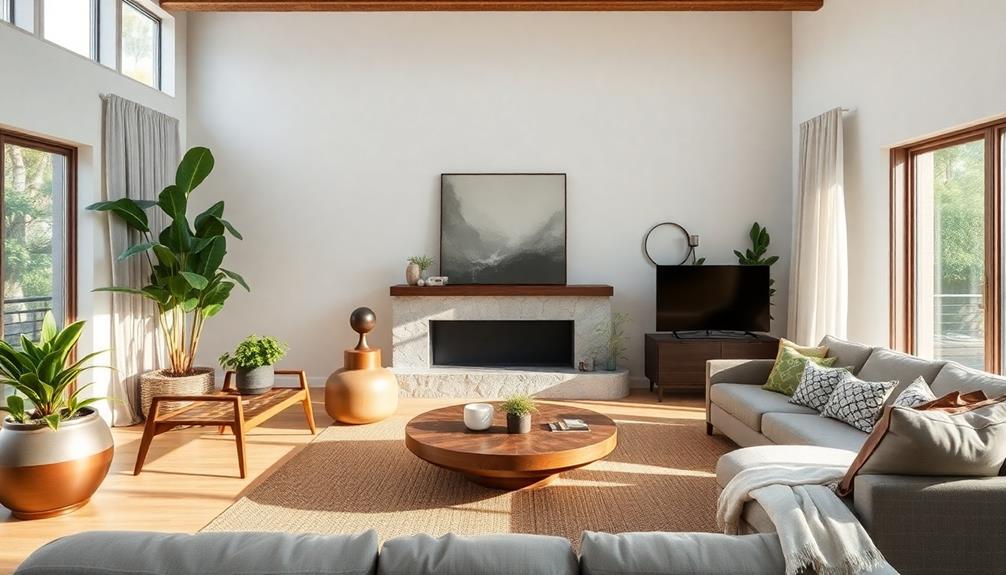
How can you create a harmonious environment in your home? Balancing the five elements—wood, fire, earth, metal, and water—is crucial for enhancing energy flow and promoting relaxation. Each element influences mood and energy, so incorporating them thoughtfully in your home design can greatly improve the quality of your space.
For example, vibrant colors and intricate patterns found in Indonesian decorative pillows can enhance the wood element, evoking feelings of growth and liveliness, while metal accents can provide clarity and structure. Understanding how these elements interact helps you avoid deficiencies; adding water features or blue decor can counteract excessive fire energy, ensuring balance and harmony throughout your home.
Utilizing Feng Shui principles, a chart can guide you in identifying which elements are lacking in your space. This way, you can make informed design choices that foster emotional and physical well-being.
Aiming for a balanced element composition not only enhances your home's aesthetic appeal but also creates a peaceful and calming atmosphere, boosting relaxation and productivity. With these adjustments, you'll cultivate a harmonious environment that resonates with positive energy and tranquility.
Frequently Asked Questions
What Are the 5 Principles of Feng Shui?
The five principles of Feng Shui are Chi Flow, Yin and Yang, the Five Elements, Clutter Clearing, and the Bagua Map. Each principle helps you create a balanced, harmonious, and energetically supportive home environment.
What Are the 5 Elements of Feng Shui?
The five elements of Feng Shui are Wood, Fire, Earth, Metal, and Water. Each element represents unique qualities and energies that influence your space and well-being, guiding you to create a harmonious environment.
How to Use Feng Shui in Your Home?
Transforming your home into a sanctuary could feel like magic! You can use feng shui by decluttering, arranging furniture wisely, adding natural elements, choosing soft colors, and enhancing lighting to create a harmonious, inviting space. Incorporating a feng shui color palette can further elevate the energy in your home, promoting balance and positivity. Opt for soothing hues like gentle greens, calming blues, or warm earth tones to foster a sense of peace and well-being. These thoughtful design choices not only enhance the visual appeal of your space but also nurture your emotional and spiritual connection to your environment.
How Important Is Feng Shui in a House?
Feng Shui's essential for your house because it optimizes energy flow, creating a balanced environment. When you embrace its principles, you enhance your well-being, promote relaxation, and foster a sense of harmony in your space.
Conclusion
By applying these five feng shui principles, you can create a harmonious space that feels complete and inviting. Decluttering not only clears physical space but also promotes mental clarity. When you arrange furniture thoughtfully and use mirrors strategically, you enhance energy flow. Balancing the five elements in your design fosters a sense of equilibrium. While some may debate the scientific basis of feng shui, many find that its practices enhance well-being, proving that intention can shape our environments profoundly.
-

 Mom5 months ago
Mom5 months agoHeartfelt Poems for Your Daughter’s Birthday
-

 Mom5 months ago
Mom5 months agoHappy Birthday Religious Wishes and Blessings
-

 Mom5 months ago
Mom5 months agoHappy 65th Birthday: Celebrate Your Special Day!
-

 Mom5 months ago
Mom5 months agoHappy Birthday in Heaven from Daughter: Remembering You
-

 Mom5 months ago
Mom5 months ago62nd Birthday Quotes for Mom: Celebrate Her Special Day
-

 Mom5 months ago
Mom5 months agoCelebrating 60 Years: Happy 60th Birthday Wishes
-

 Special Occasions4 months ago
Special Occasions4 months agoUplifting Words: Inspirational Church Anniversary Messages!
-

 Mom5 months ago
Mom5 months agoCelebrate a Joyous Happy 70th Birthday Milestone!

















